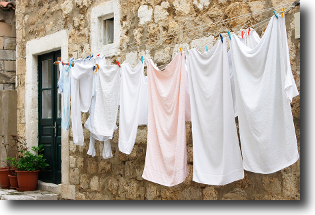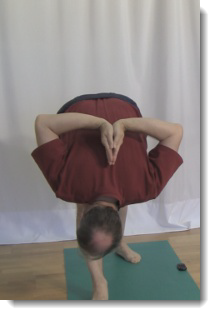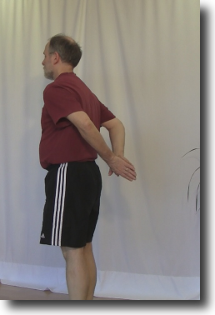“The clothes should dry quickly with all this wind” thought Alice as she approached the clothesline.
Alice started to pull the clothes in only to discover that they were wrapped around the line. The clothesline is stuck and Alice is going to be working really hard to get the clothes untangled before she can get them off of the line.
Alice’s experience with the clothes getting stuck on the clothesline is similar to what happens to her hands when she does Parsvottanasana. She can only get her hands part way up her back when they get tangled in her clothes. Her hands are in the clothesline trap.
There is a simple technique that Alice can use to avoid the clothesline trap, but first we need to have a look at Parsvottanasana and how Alice gets stuck in the trap before we can learn how to avoid it.
What is Parsvottanasana
Parsvottanasana is a standing forward fold with the feet about 3 feet apart. The unique part of this pose is that you have your palms together behind your back and up between your shoulder blades.
Parsvottanasana is part of the Standing Series of Ashtanga Yoga. It appears in the middle of the series.
Parsvottanasana which translates as “Intense Side Stretch”, stretches the spine, shoulders, wrists, hips and hamstrings.
How to do Parsvottanasana
You enter this pose from Tadasana, standing at the front of your mat with your feet together, your toes touching and a slight gap between your heels.
— Bring your arms behind your back, place your palms together and bring them up your back between your shoulder blades. Your elbows will be pointing down and your little fingers will be pressing gently into your spine between your shoulder blades.
— Turn around and face the back of your mat
— While keeping your hips square with the end of your mat take a step with your right foot. There will be almost a leg length between your feet. Your right foot is pointing at the end of the mat and your left foot, the back foot, is turned slightly out to the side. The heel of your right foot lines up with the heel of your left foot.
— Finally you bring the top of your hips forward and down towards your right thigh and gaze towards your right big toe.
Eventually you will be resting your torso on your right thigh and your palms will be flat together with your hands between your shoulder blades.
What is the problem
One of the challenges with this pose is getting your hands together behind your back and up between your shoulder blades without getting stuck in your clothes and avoiding the clothesline trap.
When you first attempt to do this pose you bring your hands together behind your back and turn them upwards and slide your hands up your back towards your shoulder blades. As you slide your hands up your back your little fingers get stuck in your clothing and you can not move your hands any further.
This is the clothesline trap. Your hands are trapped by your clothes and can move no further. Even though you may be able to get your hands higher they are stuck in your clothes.
There is however an easy way to avoid the clothesline trap and get your hands higher up your back.
How to avoid the clothesline trap
You can avoid this problem by keeping your hands away from your back for as long as possible while you bring them up between your shoulder blades.
When you bring your hands together behind your back, your palms will be touching and your fingers will be pointing down towards the floor.
From here move your joined palms away from back. This will require more flexibility in your shoulder blades in order to accomplish this.
Once you have your hands away from your back, then turn them inwards and upwards. This is the critical step. As you turn your hands from pointing down to pointing up you must keep them away from your back.
Now that your hands are pointing upwards you must continue to keep them away from your back as you start moving them up your back towards your shoulder blades.
Eventually you will reach your destination and you can let your little fingers rest against your back and continue on with the rest of the pose.
But my wrists hurt when I turn my hands upwards
If you are unable to get your palms together and your wrist are hurting when you bring your arms together, your shoulders are probably too tight and you should read the article “How to protect your wrists in Parsvottanasana”. It will give you several alternatives to protect your wrists and work within the limitation of your shoulder flexibility.
But my fingers get stuck when I rotate my hands
Your teacher can help you to keep your hands away from your back when you start the rotation. They can hold your hands away from your back and help you to turn them upwards and then guide them up between your shoulder blades.
If the teacher is not available, you can let your wrists move away from each other a little bit and then rotate your hands. This extra space between your wrists should let you get your hands a little further away from your back and give you the space you need to rotate your hands upwards.
Summary
If you find that your hands are getting stuck in the clothesline trap work on keeping your hands away from your back as you move them up between your shoulder blades.
Next Steps
Avoiding the clothesline trap can be difficult to do because your hands are behind your back and you can not see what is going on. Ask your teacher to give you a hand learning the movement.
Once you become familiar with the movement of your hands you will be able to avoid the clothesline trap every time.






